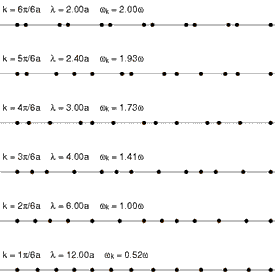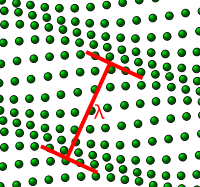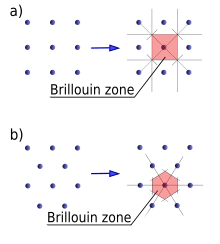User:RedAcer/phonon
This article needs additional citations for verification. (February 2010) |

A phonon is a collective excitation in a periodic, elastic arrangement of atoms or molecules in condensed matter, such as solids and some liquids. Often referred to as a quasiparticle,[1] it represents an excited state in the quantum mechanical quantization of the modes of vibrations of elastic structures of interacting particles.
Phonons play a major role in many of the physical properties of solids, including a material's thermal and electrical conductivities. Hence the study of phonons is an important part of solid state physics.
A phonon is a quantum mechanical description of a special type of vibrational motion, in which a lattice uniformly oscillates at the same frequency. In classical mechanics this is known as normal mode. Normal mode is important because any arbitrary lattice vibration can be considered as a superposition of these elementary vibrations (cf. Fourier analysis). While normal modes are wave-like phenomena in classical mechanics, they have particle-like properties in the wave–particle duality of quantum mechanics.
The name phonon comes from the Greek word φωνή (phonē), which translates as sound or voice because long-wavelength phonons give rise to sound.
The concept of phonons was introduced by Russian physicist Igor Tamm.
Lattice dynamics
[edit]The equations in this section either do not use axioms of quantum mechanics or use relations for which there exists a direct correspondence in classical mechanics.
For example, consider a rigid regular, crystalline, i.e. not amorphous, lattice composed of N particles. We will refer to these particles as atoms, although in a real solid these may be molecules. N is some large number, say around 1023 (on the order of Avogadro's number) for a typical sample of solid. If the lattice is rigid, the atoms must be exerting forces on one another to keep each atom near its equilibrium position. These forces may be Van der Waals forces, covalent bonds, electrostatic attractions, and others, all of which are ultimately due to the electric field force. Magnetic and gravitational forces are generally negligible. The forces between each pair of atoms may be characterized by a potential energy function V that depends on the distance of separation of the atoms. The potential energy of the entire lattice is the sum of all pairwise potential energies:[2]
where is the position of the th atom, and is the potential energy between two atoms.
It is difficult to solve this many-body problem in full generality, in either classical or quantum mechanics. In order to simplify the task, we introduce two important approximations. First, we perform the sum over neighboring atoms only. Although the electric forces in real solids extend to infinity, this approximation is nevertheless valid because the fields produced by distant atoms are screened. Secondly, we treat the potentials as harmonic potentials: this is permissible as long as the atoms remain close to their equilibrium positions. (Formally, this is done by Taylor expanding about its equilibrium value to quadratic order, giving proportional to the displacement and the elastic force simply proportional to . The error in ignoring higher order terms remains small if remains close to the equilibrium position).
The resulting lattice may be visualized as a system of balls connected by springs. The following figure shows a cubic lattice, which is a good model for many types of crystalline solid. Other lattices include a linear chain, which is a very simple lattice which we will shortly use for modelling phonons. Other common lattices may be found in the article on crystal structure.
The potential energy of the lattice may now be written as
Here, is the natural frequency of the harmonic potentials, which we assume to be the same since the lattice is regular. is the position coordinate of the th atom, which we now measure from its equilibrium position. The sum over nearest neighbors is denoted as "(nn)".
Lattice waves
[edit]
Due to the connections between atoms, the displacement of one or more atoms from their equilibrium positions will give rise to a set of vibration waves propagating through the lattice. One such wave is shown in the figure to the right. The amplitude of the wave is given by the displacements of the atoms from their equilibrium positions. The wavelength is marked.
There is a minimum possible wavelength, given by twice the equilibrium separation a between atoms. As we shall see in the following sections, any wavelength shorter than this can be mapped onto a wavelength longer than 2a, due to the periodicity of the lattice.
Not every possible lattice vibration has a well-defined wavelength and frequency. However, the normal modes do possess well-defined wavelengths and frequencies.
Linear chain - Classical treatment
[edit]Linear chain - Quantum treatment
[edit]Consider a one-dimensional quantum mechanical harmonic chain of N identical atoms. This is the simplest quantum mechanical model of a lattice, and we will see how phonons arise from it. The formalism that we will develop for this model is readily generalizable to two and three dimensions. The Hamiltonian for this system is
where is the mass of each atom, and and are the position and momentum operators for the th atom. A discussion of similar Hamiltonians may be found in the article on the quantum harmonic oscillator.
We introduce a set of "normal coordinates" , defined as the discrete Fourier transforms of the 's and "conjugate momenta" defined as the Fourier transforms of the 's:
The quantity will turn out to be the wave number of the phonon, i.e. divided by the wavelength. It takes on quantized values, because the number of atoms is finite. The form of the quantization depends on the choice of boundary conditions; for simplicity, we impose periodic boundary conditions, defining the th atom as equivalent to the first atom. Physically, this corresponds to joining the chain at its ends. The resulting quantization is
The upper bound to comes from the minimum wavelength, which is twice the lattice spacing , as discussed above.
By inverting the discrete Fourier transforms to express the 's in terms of the 's and the 's in terms of the 's, and using the canonical commutation relations between the 's and 's, we can show that
In other words, the normal coordinates and their conjugate momenta obey the same commutation relations as position and momentum operators! Writing the Hamiltonian in terms of these quantities,
where
Notice that the couplings between the position variables have been transformed away; if the 's and 's were Hermitian (which they are not), the transformed Hamiltonian would describe uncoupled harmonic oscillators.
The harmonic oscillator eigenvalues or energy levels for the mode are :
If we ignore the zero-point energy then the levels are evenly spaced at :
So a minimum amount of energy must be supplied to the harmonic oscillator(or normal mode) to move it to the next energy level. In comparison to the photon case when the electromagnetic field is quantised, the quantum of vibrational energy is called a phonon.
All quantum systems show wave-like and particle-like properties. The particle-like properties of the phonon are best understood using the methods of second-quantisation and operator techniques described later.
Three Dimensional Lattice
[edit]This may be generalized to a three-dimensional lattice. The wave number k is replaced by a three-dimensional wave vector k. Furthermore, each k is now associated with three normal coordinates.
The new indices s = 1, 2, 3 label the polarization of the phonons. In the one dimensional model, the atoms were restricted to moving along the line, so the phonons corresponded to longitudinal waves. In three dimensions, vibration is not restricted to the direction of propagation, and can also occur in the perpendicular planes, like transverse waves. This gives rise to the additional normal coordinates, which, as the form of the Hamiltonian indicates, we may view as independent species of phonons.
Dispersion relation
[edit]
In the above discussion, we have obtained an equation that relates the angular frequency of a phonon, , to its wave number :
This is known as a dispersion relation.
The speed of propagation of a phonon, which is also the speed of sound in the lattice, is given by the slope of the dispersion relation, (see group velocity.) At low values of (i.e. long wavelengths), the dispersion relation is almost linear, and the speed of sound is approximately , independent of the phonon frequency. As a result, packets of phonons with different (but long) wavelengths can propagate for large distances across the lattice without breaking apart. This is the reason that sound propagates through solids without significant distortion. This behavior fails at large values of , i.e. short wavelengths, due to the microscopic details of the lattice.
For a crystal that has at least two atoms in a unit cell (which may or may not be different), the dispersion relations exhibit two types of phonons, namely, optical and acoustic modes corresponding to the upper and lower sets of curves in the diagram, respectively. The vertical axis is the energy or frequency of phonon, while the horizontal axis is the wave-vector. The boundaries at -km and km are those of the first Brillouin zone. The blue, violet, and brown curves are those of longitudinal acoustic, transverse acoustic 1, and transverse acoustic 2 modes, respectively.
In some crystals the two transverse acoustic modes have exactly the same dispersion curve. It is also interesting that for a crystal with N ( > 2) different atoms in a primitive cell, there are always three acoustic modes. The number of optical modes is 3N - 3. Many phonon dispersion curves have been measured by neutron scattering.
The physics of sound in fluids differs from the physics of sound in solids, although both are density waves: sound waves in fluids only have longitudinal components, whereas sound waves in solids have longitudinal and transverse components. This is because fluids can't support shear stresses. (but see viscoelastic fluids, which only apply to high frequencies, though).
Interpretation of phonons using second quantisation techniques
[edit]In fact, the above-derived Hamiltonian looks like the classical Hamiltonian function, but if it is interpreted as an operator, then it describes a quantum field theory of non-interacting bosons. This leads to new physics.
The energy spectrum of this Hamiltonian is easily obtained by the method of ladder operators, similar to the quantum harmonic oscillator problem. We introduce a set of ladder operators defined by
The ladder operators satisfy the following identities:
As with the quantum harmonic oscillator, we can then show that and respectively create and destroy one excitation of energy . These excitations are phonons.
We can immediately deduce two important properties of phonons. Firstly, phonons are bosons, since any number of identical excitations can be created by repeated application of the creation operator . Secondly, each phonon is a "collective mode" caused by the motion of every atom in the lattice. This may be seen from the fact that the ladder operators contain sums over the position and momentum operators of every atom.
It is not a priori obvious that these excitations generated by the operators are literally waves of lattice displacement, but one may convince oneself of this by calculating the position-position correlation function. Let denote a state with a single quantum of mode excited, i.e.
One can show that, for any two atoms and ,
which is exactly what we would expect for a lattice wave with frequency and wave number .
In three dimensions the Hamiltonian has the form
Acoustic and optical phonons
[edit]Solids with more than one type of atom, with either different masses or bonding strengths, in the smallest unit cell exhibit two types of phonons: acoustic phonons and optical phonons.
In terms of the dispersion relations for phonons, acoustic phonons exhibit linear dispersion, i.e., a linear relationship between frequency and phonon wavevector, in the long-wavelength limit. The frequencies of acoustic phonons, which are the phonons described above, tend to zero with longer wavelength, and correspond to sound waves in the lattice. Longitudinal and transverse acoustic phonons are often abbreviated as LA and TA phonons, respectively.
Optical phonons, however, have a non-zero frequency at the Brillouin zone center and show no dispersion near that long wavelength limit. They are called optical because in ionic crystals, such as sodium chloride, they are excited by infrared radiation. This is because they correspond to a mode of vibration where positive and negative ions at adjacent lattice sites swing against each other, creating a time-varying electrical dipole moment. Optical phonons that interact in this way with light are called infrared active. Optical phonons that are Raman active can also interact indirectly with light, through Raman scattering. Optical phonons are often abbreviated as LO and TO phonons, for the longitudinal and transverse modes respectively.
Crystal momentum
[edit]
It is tempting to treat a phonon with wave vector as though it has a momentum , by analogy to photons and matter waves. This is not entirely correct, for is not actually a physical momentum; it is called the crystal momentum or pseudomomentum. This is because is only determined up to multiples of constant vectors, known as reciprocal lattice vectors. For example, in our one-dimensional model, the normal coordinates and are defined so that
where
for any integer . A phonon with wave number is thus equivalent to an infinite "family" of phonons with wave numbers , , and so forth. Physically, the reciprocal lattice vectors act as additional "chunks" of momentum which the lattice can impart to the phonon. Bloch electrons obey a similar set of restrictions.

It is usually convenient to consider phonon wave vectors which have the smallest magnitude in their "family". The set of all such wave vectors defines the first Brillouin zone. Additional Brillouin zones may be defined as copies of the first zone, shifted by some reciprocal lattice vector.
It is interesting that similar consideration is needed in analog-to-digital conversion where aliasing may occur under certain conditions.
Thermodynamics
[edit]The thermodynamic properties of a solid are directly related to its phonon structure. The entire set of all possible phonons that are described by the above phonon dispersion relations combine in what is known as the phonon density of states which determines the heat capacity of a crystal.
At absolute zero temperature, a crystal lattice lies in its ground state, and contains no phonons. A lattice at a non-zero temperature has an energy that is not constant, but fluctuates randomly about some mean value. These energy fluctuations are caused by random lattice vibrations, which can be viewed as a gas of phonons. (The random motion of the atoms in the lattice is what we usually think of as heat.) Because these phonons are generated by the temperature of the lattice, they are sometimes referred to as thermal phonons.
Unlike the atoms which make up an ordinary gas, thermal phonons can be created and destroyed by random energy fluctuations. In the language of statistical mechanics this means that the chemical potential for adding a phonon is zero. This behavior is an extension of the harmonic potential, mentioned earlier, into the anharmonic regime. The behavior of thermal phonons is similar to the photon gas produced by an electromagnetic cavity, wherein photons may be emitted or absorbed by the cavity walls. This similarity is not coincidental, for it turns out that the electromagnetic field behaves like a set of harmonic oscillators; see Black-body radiation. Both gases obey the Bose-Einstein statistics: in thermal equilibrium and within the harmonic regime, the probability of finding phonons (or photons) in a given state with a given angular frequency is:
where is the frequency of the phonons (or photons) in the state, is Boltzmann's constant, and is the temperature.
Operator formalism
[edit]The phonon Hamiltonian is given by
In terms of the operators, these are given by
Here, in expressing the Hamiltonian (quantum mechanics) in operator formalism, we have not taken into account the term, since if we take an infinite lattice or, for that matter a continuum, the terms will add up giving an infinity. Hence, it is "renormalized" by putting the factor of to 0 arguing that the difference in energy is what we measure and not the absolute value of it. Hence, the factor is absent in the operator formalised expression for the Hamiltonian.
The ground state also called the "vacuum state" is the state composed of no phonons. Hence, the energy of the ground state is 0. When, a system is in state , we say there are phonons of type . The are called the occupation number of the phonons. Energy of a single phonon of type being , the total energy of a general phonon system is given by . In other words, the phonons are non-interacting. The action of creation and annihilation operators are given by
and,
i.e. creates a phonon of type while annihilates. Hence, they are respectively the creation and annihilation operator for phonons. Analogous to the Quantum harmonic oscillator case, we can define particle number operator as . The number operator commutes with a string of products of the creation and annihilation operators if, the number of 's are equal to number of 's.
Phonons are bosons since, i.e. they are symmetric under exchange.[3]
See also
[edit]- Boson
- Fracton
- Rayleigh wave
- Brillouin scattering
- Linear elasticity
- Phononic crystal
- Relativistic heat conduction
- Surface acoustic wave
- Rigid Unit Modes
- Surface phonon
- SASER
- Thermal conductivity
Notes
[edit]References
[edit]- ^ F. Schwabel, Advanced Quantum Mechanics, 4th Ed., Springer (2008), p. 253
- ^ Krauth, Werner (2006-04). Statistical mechanics: algorithms and computations. International publishing locations: Oxford University Press. pp. 231–232. ISBN 9780198515364.
{{cite book}}: Check date values in:|date=(help) - ^ Feynman, Richard P. (1982). Statistical Mechanics, A Set of Lectures. Reading, Massachusetts: The Benjamin/Cummings Publishing Company, Inc. p. 159. ISBN Clothbound: 0-8053-2508-5, Paperbound: 0-8053-2509-3.
{{cite book}}:|access-date=requires|url=(help); Check|isbn=value: invalid character (help); Check date values in:|accessdate=(help); Cite has empty unknown parameter:|coauthors=(help)
External links
[edit]- Optical and acoustic modes
- Phonons in a One Dimensional Microfluidic Crystal [1] and [2] with movies in [3].




























![{\displaystyle \left[Q_{k},\Pi _{k'}\right]=i\hbar \delta _{kk'}\quad ;\quad \left[Q_{k},Q_{k'}\right]=\left[\Pi _{k},\Pi _{k'}\right]=0.\ }](https://wikimedia.riteme.site/api/rest_v1/media/math/render/svg/102d63d8a06201272ae2bba73b799e2d9091278b)














![{\displaystyle [a_{k},a_{k'}^{\dagger }]=\delta _{kk'}}](https://wikimedia.riteme.site/api/rest_v1/media/math/render/svg/b0be971d0ada56a9633e4a4d81f2af81b2ba19ce)
![{\displaystyle [a_{k},a_{k'}]=[a_{k}^{\dagger },a_{k'}^{\dagger }]=0.}](https://wikimedia.riteme.site/api/rest_v1/media/math/render/svg/bf394f5d69cfdd110a56f792acd03472cb034579)







![{\displaystyle \langle k|x_{j}(t)x_{\ell }(0)|k\rangle ={\frac {\hbar }{Nm\omega _{k}}}\cos \left[k(j-\ell )a-\omega _{k}t\right]+\langle 0|x_{j}(t)x_{\ell }(0)|0\rangle }](https://wikimedia.riteme.site/api/rest_v1/media/math/render/svg/fe8a3c2beb786c78096256ab33e9f42a04322743)



























